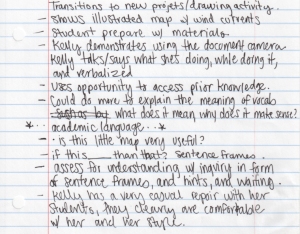Principle P2: Practice Differentiated Instruction
The HOPE principle P2 directs teachers to – practice differentiated instruction. The word differentiation can have many interpretations in terms of practicing instruction. I believe the HOPE principle P2 refers to the act of revising or adapting instruction for specific students based on the teacher’s ability to take into account student assets, such as special learning needs, or features of personality and environment that affect learning. I believe the act of practicing differentiated instruction can occur during planning as well as during instruction, and teachers who take time to build rapport with students tend to have more ability to effectively modify tasks or provide options for students who are struggling.
Educator and author Carol Ann Tomlinson (1999) says differentiation means giving students multiple options for taking in information. Differentiating instruction means that you observe and understand the differences and similarities among students and use this information to plan instruction (Tomlinson, 1999). Within the dynamic of a classroom, differentiation can feel like an impossible task, especially when you consider how every student could potentially “need” some form of differentiation. I have come to recognize, however, this is a skill that teachers can improve with experience, creativity, flexibility, and a focused eye for students who perform below standard.
A few weeks ago I was privileged to observe a teacher who despite only 5 years of teaching experience, seems to have a natural talent to differentiating instruction both when planning lessons and during instruction. During Ms. Kelly Konicky’s 7th grade science lesson, I took notes that I feel offer evidence for the methods she used to differentiate during her instruction. The following is a list based on Tomlinson’s (1999) key principles of differentiating instruction accompanied by observation notes I made of Ms. Konicky’s instruction:
- Ongoing, formative assessment: Ms. Konicky continually assesses to identify students’ strengths so she can meet students where they are and help them move forward. I observed her doing this during the lesson by asking the same question in multiple ways, by asking multiple students to answer the same questions to provide multiple perspectives, and by simplifying the concepts for students who make errors.

- Recognition of diverse learners: Ms. Konicky clearly has developed a healthy rapport with her students in the class I observed, which was indicated by how she worked with them individually as she assessed for understanding. She spent adequate time ensuring students could articulate themselves, and then rephrased or used visual aids to make the learning target more clear for students.Ms. Konicky supports her weakest students first, and does so in a way that is inclusive and friendly.
- Problem Solving: Ms. Konicky encourages all students to explore big ideas and expand their understanding of key concepts. Using a casual Socratic discussion model while illustrating concepts under a document camera, students voiced ideas freely on how and why the earth’s rotation effected global currents. Ms. Konicky also allowed students to solve their own problems, with hints and support, and by simply allowing them time to think – a nice approach.
 Choice: While my notes do not show this evidence, but Ms. Konicky also effectively offers choice to students as a form of differentiation. By simply negotiating the order of tasks, Ms. Konicky helped engage student interest (students chose the craft project to do before the writing task). This shows effective planning because my guess was that Ms. Konicky already knows her students preferences but offers them choice because they will feel more invested in their learning.
Choice: While my notes do not show this evidence, but Ms. Konicky also effectively offers choice to students as a form of differentiation. By simply negotiating the order of tasks, Ms. Konicky helped engage student interest (students chose the craft project to do before the writing task). This shows effective planning because my guess was that Ms. Konicky already knows her students preferences but offers them choice because they will feel more invested in their learning.
In less than 50 minutes, I was impressed to observe Ms. Konicky use a number of differentiation strategies to help students access and retain the information she was offering. Students were discussing, responding to inquiry, writing notes, drawing and labeling diagrams, cutting paper to create a model, and finally drawing conclusions about what they had learned. Ms. Konicky’s ability to create a casual and personable atmosphere with her students clearly makes adapting and being flexible with students easier, because she knows them and they know her. I think to improve my own instructional differentiation, I should continue to build my student-teacher rapport so that I can recognize diverse learners and use that knowledge to incorporate a variety of instructional methods to give students multiple modes of acquiring knowledge and skills I teach.
Reference
Tomlinson, C.A. (1999). How to Differentiate Instruction in Mixed Ability Classrooms (2nd Edition). Alexandria, VA: Assn for Supervision & Curric Development (ASCD).

